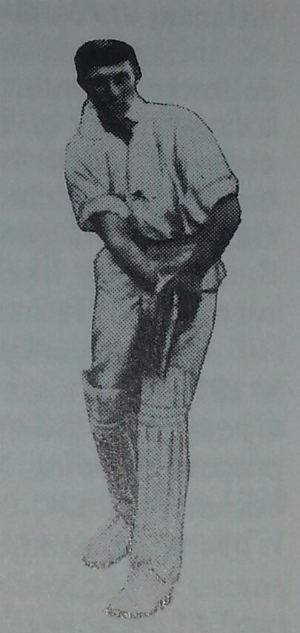Full name Roy Lindsay Park Name Roy Park Nickname(s) Little Doc Role Cricket Player | Original team Wesley College | |
 | ||
Date of birth (1892-07-30)30 July 1892 Date of death 23 January 1947(1947-01-23) (aged 54) | ||
Roy Lindsay Park (30 July 1892, Charlton, Victoria – 23 January 1947, Middle Park, Victoria) was an all-round athlete and doctor. The son of a Methodist minister, he played cricket for Australia and also Australian rules football in the Victorian Football League (VFL). He was educated at Wesley College, Melbourne. Park also served in the Australian Imperial Force in World War I.
Contents
Football career
Park started his senior VFL career at University, making his debut in 1912. He had an immediate impact as the club's leading goal kicker with 22. Park's 53 goals in the 1913 VFL season was bettered only by Fitzroy's Jimmy Freake with 56. Park had medical studying commitments at Melbourne University in 1914, leaving him free for few games, but still managed to kick 36 goals for the season that was University's last in the VFL competition.
In 1915 Park played with VFL club Melbourne, where he kicked 35 goals in 13 games, but was suspended for four matches for striking Gerry Balme of St Kilda, despite three witnesses coming forward to say that Park had not hit the player at all. Park refused to play football again after his suspension, ending his VFL career with 146 goals in 57 matches. However, following the end of the war, Park returned to football, playing with Footscray Football Club, who were then a member of the Victorian Football Association (VFA). In the 1920 VFA second semi-final, Park won the match for Footscray against North Melbourne Football Club with a dramatic kick that dribbled through for a goal with less than ten seconds left on the clock.
World War I
Being a professional doctor, Park enrolled in the Australian Army Medical Corps of the Australian Imperial Force on 12 July 1917. Upon enrolling, Park was given the rank of captain and left Australia on 4 August 1917 aboard the HMAT Themistocles. He served with the 5th Field Ambulance Unit and was mentioned in dispatches in the London Gazette on 11 July 1919 and in the Commonwealth of Australia Gazette on 30 October 1919. Park returned safely to Australia on 2 June 1919 after the conclusion of World War I.
Cricket career
Park was a cricket prodigy at Wesley College. His schoolmate Robert Menzies, future Prime Minister of Australia, recalled reading Shakespeare behind the school practice nets, "so that he could partake of the bard whilst watching Park bat." Park played for South Melbourne Cricket Club in the Victorian Cricket Association (VCA), and starred as a right-handed opening batsman, including a 315-run opening partnership with future Australian Test captain Bill Woodfull, for many years a club record. He became the youngest man to lead the batting averages for Melbourne Cricket Club. He was chosen as part of Warwick Armstrong's 1914/15 Australian team for a stillborn tour of South Africa:
At Melbourne, Park had been one of the youngsters sent to the "special net" for Armstrong's attention. Armstrong had been impressed, Park awestruck, later crediting Armstrong with "most of my cricket brains". They were an odd sight in partnership, like a planet and its satellite, but their simpatico was deep. During the match against South Australia, for example, Park joined his captain with an hour left of the second day and shared a thunderous stand. Over lunch on the third day, with Park 226 and himself 101, Armstrong recalled his own eight-year-old record score for Victoria: "Parky, you haven't far to go to beat my 250. I promise to do my best to stop there while you make them." Park did not make it, but always remembered the gesture.
Park also notched up some fine performances for Victoria, and soon earned a Test call-up in the 1920–1921 season. He was unsuccessful in his debut against England at the Melbourne Cricket Ground (MCG), making a first-ball duck in his only innings, and bowling a single over of off-spinners which went for nine runs. He was said to have been called late during the night for medical duties, and not to have got any sleep before his debut. He never played Test cricket again. Legend has it that his wife, who was watching in the stands, dropped her knitting as he prepared to face his first ball, bent down to retrieve it at the moment of delivery, and thus missed his entire Test career.
At first-class level, he made 2514 runs at an average of just under 40, scoring nine centuries, with a highest score of 228. Following his retirement from cricket, Park held numerous administrative positions, including the South Melbourne delegate to the VCA and Victorian selector. In 1953 a memorial plaque honouring Park was unveiled in South Melbourne by the Mayor of South Melbourne.
Park's son-in-law, Ian Johnson, who married his daughter, Lal, was a captain of the Australian cricket team and a member of The Invincibles.
